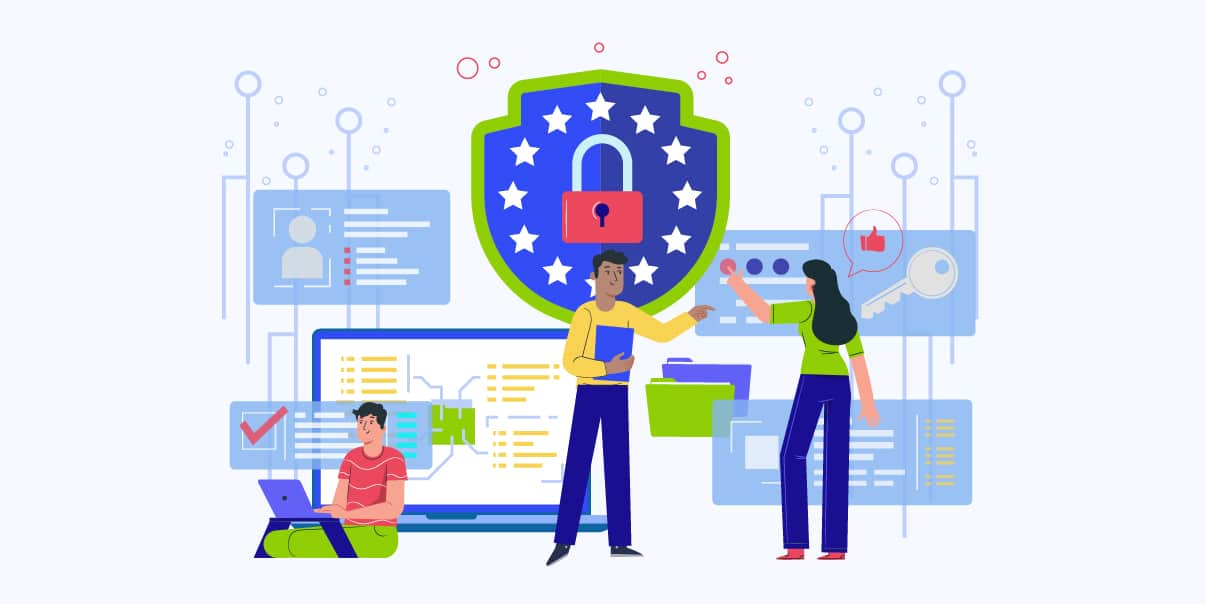Security Testing Methodologies: Key Elements and Best Practices

Have you ever wondered how websites, web applications, and mobile apps are kept safe? Well, security testing is an excellent way to do that. It is a process that involves analyzing and evaluating systems, apps, and networks to identify and mitigate potential vulnerabilities. Security testing ensures that only authorized users can access a system or website. It also looks for flaws in the network and allows testers to fix them before they become security issues.
Security testing involves different methods and best practices to keep your data secure. By understanding the security testing methodologies, you can ensure your data remains secure. Let’s explore this exciting topic further so you can stay safe online.
What Is Security Testing?
Security testing plays a huge role in the software development lifecycle. It is like having an invisible guard protecting your computer or device. Also, it checks everything in your system to ensure it is safe from suspicious threats. For example, suppose someone tries to get into your computer without permission. In that case, security testing will tell you so you can stop them and keep your information safe.
Security tests assess a system’s security measures, focusing on data privacy, access control, and cyberattack resilience. Also, security testing helps developers ensure their systems are secure from malicious activities. It allows them to identify weaknesses, misconfigurations, or other problems in the system. These tests use tools to scan the system for potential vulnerabilities.
The Different Security Testing Methodologies
Security testing methodologies help protect you from potential cyber threats. These involve different strategies and techniques to ensure your information is always safe. So, here are the various security testing techniques you can use:
Penetration Testing
Penetration testing methodology uses simulated attacks to check weak points in an app. It helps identify any security vulnerabilities or misconfigurations. A penetration test lets security professionals take the necessary measures to secure systems. Also, it helps catch security weaknesses before they become dangerous. Using an integrated penetration testing tool can protect your system.
Vulnerability Scanning
Vulnerability scanning is a testing method that uses automated tools. It identifies potential loopholes that hackers can use to get into your system. Also, it ensures that the system is up-to-date with new security threats and measures.
Risk Assessment
Risk assessment looks at the potential security threats that affect a system. It evaluates the threats’ probability, impact, and severity. Thus, it shows the overall security posture of an organization.
Social Engineering Testing
Social engineering testing is a security testing method that focuses on human behavior. It helps identify vulnerabilities, like phishing emails or malicious software downloads. Experts look for weaknesses a hacker could exploit to gain access. For example, they might check whether passwords are strong enough or security protocols are too lax. By finding these issues early on, you can fix them before malicious activity happens.
Application Security Testing
Application security testing ensures that apps are secure and compliant with regulations. It works by testing the program’s code to ensure it is secure. And this helps keep your information safe when you are on the Internet. The tests assess various aspects of an application, including authorization mechanisms, encryption, input validation, and access control.
Network Security Testing
Network security testing determines possible loopholes leading to data loss or leakage. It uses tools to scan the network for potential vulnerabilities. Also, testers look for any viruses or malware lurking on your system and get rid of them.
Mobile Application Security Testing
Mobile app security testing identifies weaknesses in Android or iOS applications. A mobile app may contain bugs that can damage your device or steal personal information. Hence, it ensures the app runs effectively on different devices and platforms.
Cloud Security Testing
Cloud security testing secures the resources and data stored in the cloud. It uses special tools to check if the cloud system is secure. These tools also look for threats that may lead to breaches or unauthorized access.
Security Testing Process
Security testing is a necessary process for keeping information safe and secure. By going through this process, you can ensure your networks are safe from unwanted intruders and threats. So, here are the steps in the security testing process that you should follow:
1. Planning and Preparation
Planning and preparing for the best results is vital. Planning involves the following:
- Understanding what you want to test
- Figuring out how to do it
- Determining which tools you need
On the other hand, preparation includes gathering resources and setting up the environment. It ensures that everything is in place for a successful testing process.
Defining the Scope and Objectives of the Testing
It means setting boundaries on what you should test. And then ensuring it meets those expectations. Hence, your information stays safe from any suspicious or dangerous activity.
Identifying and Selecting the Appropriate Testing Tools and Methodologies
Keep your information safe by knowing the right tools and penetration testing methodologies. It looks at what is going in and out of your system to ensure it is secure. You must know what you want to test, how, and what tools you need. Also, you must know what resources you have and set up the environment for successful testing.
Gathering and Analyzing Security Requirements
Security requirements are crucial for keeping your system safe. They include safety measures, like passwords and antivirus programs. Plus, they ensure your software is up-to-date.
Gathering security requirements means knowing the controls needed to keep a system secure. Analyzing them means ensuring they make sense and work together.
Determining and Selecting the Test Environment
The test environment is where security testing takes place. You must identify and select the best test environment depending on your goals. Moreover, you should configure the test environment appropriately, including setting up necessary tools, data, and access controls, to minimize potential risks.
Creating a Testing Schedule and Assigning Responsibilities
To keep the testing process on track, create a schedule, and assign responsibilities. Having a clear plan with specific tasks is vital for testing.
It involves setting deadlines, creating tasks, recording results, and assigning roles to testers. It ensures that everyone knows their role in the security testing process.
2. Execution and Reporting
During the execution phase, testers perform security tests per the established plan, documenting and reporting the results for further analysis. Then, analyze the results and report them to the stakeholders in compliance with regulations.
Executing the Chosen Testing Methodologies
Testers must use the chosen testing methodologies and stick to the plan and timeline. You should perform all tests within the given deadline.
Documenting and Reporting the Results of the Testing
Documenting and reporting the results of testing involves creating a detailed report. It includes all the findings, such as potential risks or weaknesses in the system. The test report should also suggest preventive measures you can take to fix issues.
Identifying and Reporting Any Vulnerabilities or Security Risks Found
This step allows testers to alert the stakeholders of any potential dangers. Also, it helps them take preventive measures against malicious attacks.
Recommending and Implementing Remediation Steps
The recommending and implementing remediation steps involve suggesting solutions to rectify security issues. This step requires testers to analyze the results of the tests carefully. They should also suggest preventive measures that you can take for a more secure system.
Communicating the Results to Relevant Stakeholders
Another critical step in security testing is communicating the results to relevant stakeholders. It involves sending a detailed report of the findings and recommendations. In addition, it helps ensure that they are aware of any potential risks in their system.
3. Maintenance and Continuous Improvement
The last step of security testing is maintenance and continuous improvement. It involves regular systems maintenance to ensure their safety against cyber threats. Also, it helps keep the system updated with the latest security technologies.
Vulnerability Management
Vulnerability management is a systematic approach to identifying, prioritizing and addressing security vulnerabilities in an app, website, or computer to ensure that sensitive information remains protected. Also, it stops you from getting into your system without permission and keeps your data safe.
It is also vital to have a vulnerability management program to protect your app or network. It protects against these threats by identifying weaknesses that make your computer vulnerable.
Continuous Monitoring and Testing
It is crucial to always look for new vulnerabilities in any system. That is why you can track and test the system for flaws continuously. When you find these weaknesses, you can fix them to ensure the system is secure and protected from harm. You must do this constantly to stay ahead of evolving threats.
Incident Response and Threat Modeling
Companies also need to prepare for unexpected things that could happen. That’s what incident response and threat modeling are all about. Incident response is a structured approach companies follow to detect, respond to, and recover from security incidents, ensuring timely and efficient handling of cybersecurity events. They create a plan that includes tasks like who to notify if an attack happens and how the company will respond.
Meanwhile, threat modeling helps companies to identify potential security threats before they happen. They can spot weaknesses and find ways to fix them by modeling various scenarios.
Best Practices in Security Testing Methodologies
Security testing uses special tools and techniques to identify potential weaknesses in systems. There are several methodologies that experts use, but here are some of the best practices:
1. Start With a Risk Assessment
Before starting the penetration tests, assess risks first. It helps you determine potential vulnerabilities and where to focus during testing.
2. Identify the Scope of Testing
Before starting security testing, identify the scope of testing. It helps determine what you need to test and which security test tools to use for successful results.
3. Use Automated Tools
Using automated tools is essential for any security testing process. It identifies potential weaknesses swiftly, ensuring your system stays safe from cyber threats.
4. Train Staff Often
Train staff often so they know the latest security protocols and best practices. It protects data from malicious attacks and keeps the system secure.
5. Keep Records Updated
Keep records updated with the latest security policies and procedures. It also helps in determining any potential threats.
6. Establish a Robust Security Policy
A robust security policy is necessary to protect your data from malicious activities. It must include all aspects of data protection, like authentication, authorization, and encryption.
7. Keep Systems Up-to-Date
Keeping systems up to date is another best practice for security testing. It ensures the system has the latest security measures and stays safe from threats.
8. Track Security Logs From Time to Time
Check security logs every time to keep track of any suspicious activity in the system. It allows you to identify possible threats fast and take preventive measures.
9. Run Regular Security Auditing
Security audits help check for any changes that could leave openings for hackers. A few examples include new software installed without permission or weak passwords used.
10. Educate Users on Proper Security Protocols
Teaching people authentication methods or configuring devices can reduce the chance of an attack.
These are some of the best practices for security testing methodologies. Following them ensures your data and system remain secure from malicious attackers. So keep up with the latest security protocols and technologies for a safe and secure network.
Importance of Security Testing Methodologies
Security testing methodologies help protect your system from threats. It helps keep your online information safe and secure. Also, it ensures that only authorized people can access the information they need.
Additionally, testing security detects if someone has already gotten in and caused damage. This way, you can fix it quickly before it becomes a bigger problem. Hence, security testing is crucial for protecting people’s digital lives.
Future Trends and Advancements in These Methodologies
Security testing is a critical topic and will continue to evolve. And more sophisticated testing methodologies will emerge over time. These can detect even the most advanced cyber threats in the future. Fortunately, many advancements and trends have made it easier to keep networks safe.
Automation
Special software programs can automate the security testing process. It makes the entire process faster and more efficient. As a result, companies can ensure their systems are safe without manual checking.
Artificial Intelligence (AI)
AI helps security testers identify potential flaws faster and more accurately than humans. Use AI’s ability to recognize patterns and uncover complex relationships. Doing so allows testers to spot weaknesses in a system’s defenses better.
Ethical Hacking
It involves employing skilled professionals, known as ethical hackers, to simulate real-world network attacks to test the system for flaws and vulnerabilities. Ethical testing is invaluable for finding vulnerabilities before malicious actors can exploit them.
These methods give you the power to protect your data from attackers. While also giving companies peace of mind when it comes to cyber security.
Conclusion
Security testing methodologies keep your system secure from malicious activities. It helps develop a robust security policy and ensures systems stay updated with the latest software testing and security testing tools.
Moreover, future trends involve harnessing the capabilities of AI and ML technologies to improve threat detection and response. Understanding these methodologies can help secure your information and protect it from harm.
Interactive Application Security Testing (IAST) and Dynamic Application Security Testing (DAST) are integral components of any company’s security strategy, as they help identify vulnerabilities in running applications.
We’re BIT Studios!
At BIT Studios we specialize in designing, building, shipping, and scaling beautiful, usable products with blazing-fast efficiency



